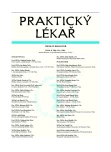Evolution and evolutionary theory for physicians
X.: Self-awareness.
Authors:
F. Koukolík
Authors‘ workplace:
Primář: MUDr. František Koukolík, DrSc.
; Národní referenční laboratoř prionových chorob
; Fakultní Thomayerova nemocnice s poliklinikou, Praha
; Oddělení patologie a molekulární medicíny
Published in:
Prakt. Lék. 2010; 90(10): 571-576
Category:
Editorial
Overview
Evolution of self-awareness is hypothetically based on
– ecological,
– interpersonal,
– extended,
– private, and
– conceptual self-knowledge.
Neuronal correlate of self-awareness might be brain´s default (intrinsic) network. Its core regions are
– ventromedial prefrontal cortex,
– posterior cingular/retrosplenial cortex,
– inferior parietal lobule,
– lateral temporal cortex,
– dorsal medial prefrontal cortex, and
– hippocampal formation.
High heritability exists for default-mode functional connectivity but its hubs are under dynamic cultural influences too.
Key words:
self-awareness, evolution, default network.
Sources
1. Addis, D.R., Wong, A.T., Schacter, D.I. Remembering the past and imagining the future: common and distinct neural substrates during event construction and elaboration. Neuropsychologia 2007, 45, p. 1363-1377.
2. Buckner, R., Andrew-Hanna, J., Schacter, D. The brain’s default network: anatomy, function and relevance to disease. Ann. NY Acad. Sci. 2008, 1124, p. 1-38.
3. Fair, D.A. Cohen, A.L., Dosenbach, N.U.C. et al. The maturing architecture of the brain´s default network. Proc. Natl. Acad. Sci. USA 2008, 105, p. 4028-4032.
4. Fox, M.D., Snyder, A.Z., Vincent, J.L. et al. The human brain is intrinsically organized into dynamic anticorrelated functional network. Proc. Natl. Acad. Sci. USA 2005, 102, p. 9673-9678.
5. Glahn, D.C., Winkler, A.M., Kochunov, P. et al. Genetic control over the resting brain. Proc. Natl. Acad. Sci. USA 2010, 107, p. 1223-1228.
6. Greene, J.D., Sommerville, R.B., Nystrom, L.E. et al. An fMRI investigation of emotional engagement in moral judgement. Science 2001, 293, p. 2105-2108.
7. Hahn, B., Ross, T.J., Stein, E.A. Cingulate activation increases dynamically with response speed under stimulus unpredictability. Cereb. Cortex 2007, 17, p. 1664-1671.
8. Chiao, J.Y., Harada, T. Komeda, H. et al. Neural basis of individualistic and collectivistic views of self. Hum. Brain. Mapp. 2009, 30, p. 2813-2820.
9. Chiao, J.Y., Harada, T., Komeda, H. et al. Dynamic cultural influences on neural representatiton of self. J. Cogn. Neurosci. 2009, 21, p. 1-11.
10. James, W. Principles of psychology. New York: Henry Holt and Co., 1890. Dostupné na: http://ia341341.us.archive.org/1/items/theprinciplesofp01jameuoft/theprinciplesofp01jameuoft.pdf
11. Johnson, M.K., Raye, C.I., Mitchell, K.J. et al. Dissociating medial frontal and posterior cingulate activity during self-reflection. SCAN 2006, 1, p. 56-64.
12. Koukolík, F. Před úsvitem, po ránu. Eseje o dětech rodičích. Praha: Karolinum, 2008, s. 177.
13. Koukolík, F. Funkční systémy lidského mozku. Praha: Galén, 2011 (v tisku).
14. Leary, M.R., Buttermore, N.R. The evolution of human Self: tracing the natural history of self-awareness. J. Theory. Soc. Behav. 2003, 33, p. 365-404.
15. Li C- S.R., Yan, P., Berquist, K.L. et al. Greater activation of the „default“ brain regions precede stop signal errors. NeuroImage 2007, 38, p. 640-648.
16. Mason, M.F., Bortin, M.I., Van Horn, J.D. et al. Wandering minds: the default network and stimulus-independent thought. Science 2007, 315, p. 393-395.
17. Otti, A., Guendel, H., Laer, L. et al. I know the pain you feel - how the human brain’s default mode predicts our resonance to another’s suffering. Neuroscience 2010, 169, p. 143-148.
18. Panksepp, J., Northhoff, G. The trans-species core SELF: the emergence of aktive cultural and neuro-ecological agents through self-related processing within subcortical-cortical midline networks. Conscious. Cogn. 2009, 18, p. 193-215.
19. Prior, H., Schwarz, A., Güntürkün, O. Mirror-induced behavior in the Magpie (Pica ): Evidence of self-recognition. PLoS. Biol. 2008 6(8), e202. doi:10.1371/journal. pbio.0060202.
20. Raichle, M.E., McLeod, M., Snyder, A. et al. A default state of brain function. Proc. Natl. Acad. Sci. USA 2001, 98, p. 676-682.
21. Saxe, R., Kahnwisher, N. People thinking about thinking people: the role of temporo-parietal function in „theory of mind“. NeuroImage 2003, 19, p. 1835-1842.
22. Sheline, Y.I., Barch, D.M., Price, J.L. et al. The default mode network and self-referential processes in depression. Proc. Natl. Acad. Sci. USA 2009, 106, p. 1942-1947.
23. Supekar, K., Musen, M., Menon, V. Development of large-scale functional brain networks in children. PLoS. Biol. 2009, 7(7), e1000157. doi:10.1371/journal.pbio.1000157.
24. Supekar, K., Uddin, L.Q., Prater, K. et al. Development of functional and structural connectivity within the default mode network in young children. NeuroImage 2010, 52, p. 290-301.
25. Vanhaudenhyuse, A., Noirhomme, Q., Tshibanda, L.T-F. et al. Default network connectivity reflects the level of concisousness in non-communicative brain-damaged patients. Brain 2010, 133, p. 161-171.
26. Vincent, J.L., Patel, H., Fox, M.D. et al. Intrinsic functional architecture in the anesthetized monkey brain. Nature 2007, 447, p. 83-86.
Labels
General practitioner for children and adolescents General practitioner for adultsArticle was published in
General Practitioner

2010 Issue 10
Most read in this issue
- Dyspnoea in elderly subjects caused by respiratory diseases
- Burn-out syndrome in physicians
- Current review of the diagnosis and treatment of pancreatic cancer
- Continuing postgraduate education of general practitioners and E-learning in the Czech Republic
